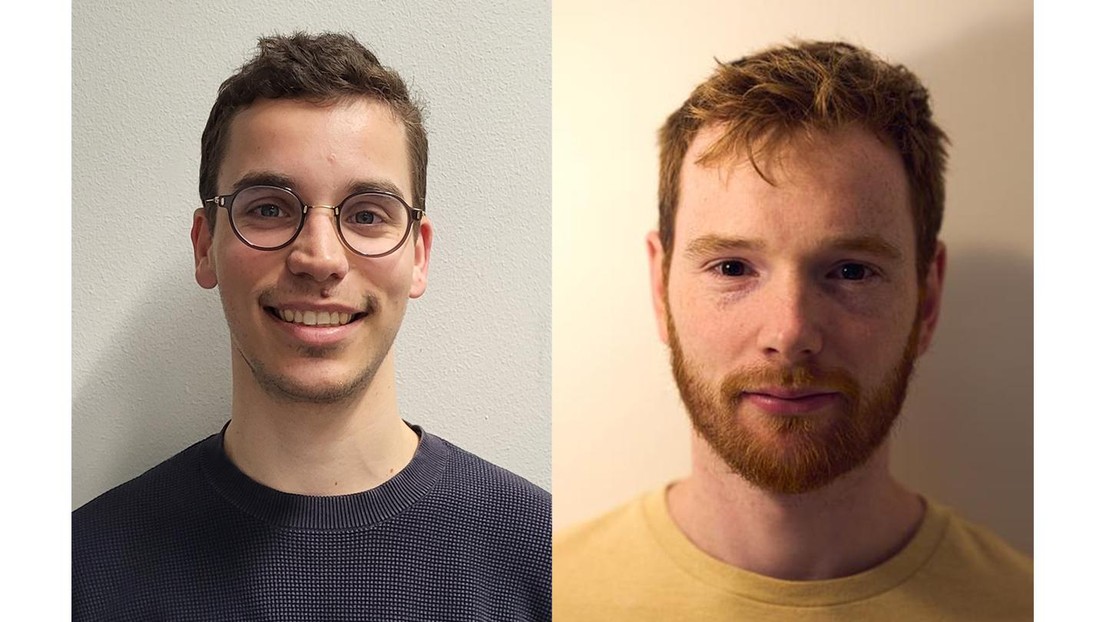Two researchers in quantum awarded SNSF Ambizione grants

Aurélien Fabre and Gregor Taylor © 2025 EPFL
Aurelién Fabre, a postdoctoral researcher in the Laboratory of Quantum Gases (LQG), and Gregor Taylor, a postdoctoral researcher in the School of Engineering's Advanced Quantum Architecture Laboratory (AQUA), have been awarded the presitigious Swiss National Science Foundation (SNSF) Ambizione grants.
These Ambizione grants are aimed at early career researchers who wish to conduct, manage and lead an independent project at a Swiss higher education institution.
Aurélien Fabre
Fabre will complete his project "Array of helium atoms for quantum-enhanced spectroscopy" at LQG, which is led by Jean-Philippe Brantut.
Quantum technologies have transformed the control of individual particles, enabling both fundamental studies and practical applications across quantum physics. Leveraging this progress, tweezer clocks, consisting of arrays of individual and isolated atoms, have proven highly effective for quantum metrology due to their narrow optical transitions, immunity to atom-atom interactions, and adaptability for quantum-enhanced measurement techniques. The remarkable accuracy and precision achieved by these setups can be used as benchmarks for testing fundamental theories, including quantum electrodynamics (QED), which describes the interactions of neutrons, protons, and electrons — basic constituents of our universe. Helium, with its simple nuclear and electronic structure (two protons, two neutrons, and two electrons), stands out for its suitability in QED tests as its atomic properties, in particular a narrow-line transition, can be directly compared with ab initio theoretical models.
Fabre’s project proposes a high-precision spectroscopy setup based on an array of individually-trapped helium atoms. The proposed apparatus will prepare cold helium atoms in optical tweezers, suppressing the interactions that often limit the accuracy of spectroscopic measurements in denser atomic systems, and will resolve helium’s narrow electronic transition with unprecedented precision, down to the Hz level — an improvement by three orders of magnitude over current methods using atomic ensembles. The system will combine single-atom manipulation with a high-finesse optical cavity to push the limits of high-resolution spectroscopy. High-fidelity, rapid, cavity-based readout will optimise measurement precision, and collective entanglement of individually trapped atoms will enable quantum-enhanced sensitivity beyond the standard quantum limit, through engineered correlations.
The high-resolution measurements enabled by this project will mark a substantial improvement over current experimental benchmarks based on helium, offering a unique platform for testing quantum electrodynamics and refining fundamental constants through direct comparison with ab initio theoretical models. The techniques developed for controlling individual helium atoms will pave the way for new applications that extend to quantum technologies.
Gregor Taylor
Taylor’s Ambizione grant is for the project "Superconducting Circuits for Superconducting Photon Detector Readout". He will spend the next four years building a small sub-group on superconducting technology within the AQUA lab, which is led by Edoardo Charbon.
Photons are the fundamental quanta of light, or the smallest indivisible unit. Detectors that can detect these singular photons, or single-photon detectors, are effectively detectors with ultimate sensitivity. When a single photon is directed at such a detector, a macroscopic pulse is output, which can then be registered and timestamped to high precision via readout circuits. Since different frequency (colour) photons have different energies, single-photon detectors also have a frequency or energy-dependence. This is particularly significant for photons in the infrared, where they have far less energy than photons in the visible region.
Superconductors are materials that exhibit a range of intriguing properties if they are cooled down to very low temperatures (~-272 C). Some of these properties mean that they can be used to make incredibly sensitive photon detectors, capable of detecting single photons with very low energy compared to other types of detectors.
The primary objective of Taylor’s project is therfore to explore the scaling up of these detectors, to large cameras, through the development of new superconducting electronics technology. The research team will explore different processing architectures, operating at 4 K (-270 C), which will allow them to process single-photon events into images using a large array of detectors. This would be a major advancement and an entirely new scientific camera, which would directly enable experiments in a diverse range of fields, including research into high dimensional quantum entanglement, deep space communication, medical technology, remote sensing of atmospheric trace gases, and the search for dark matter.